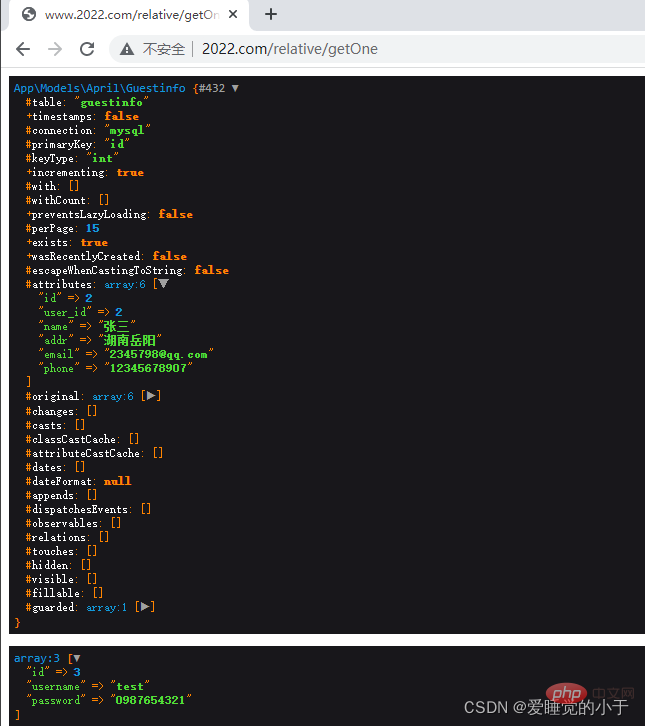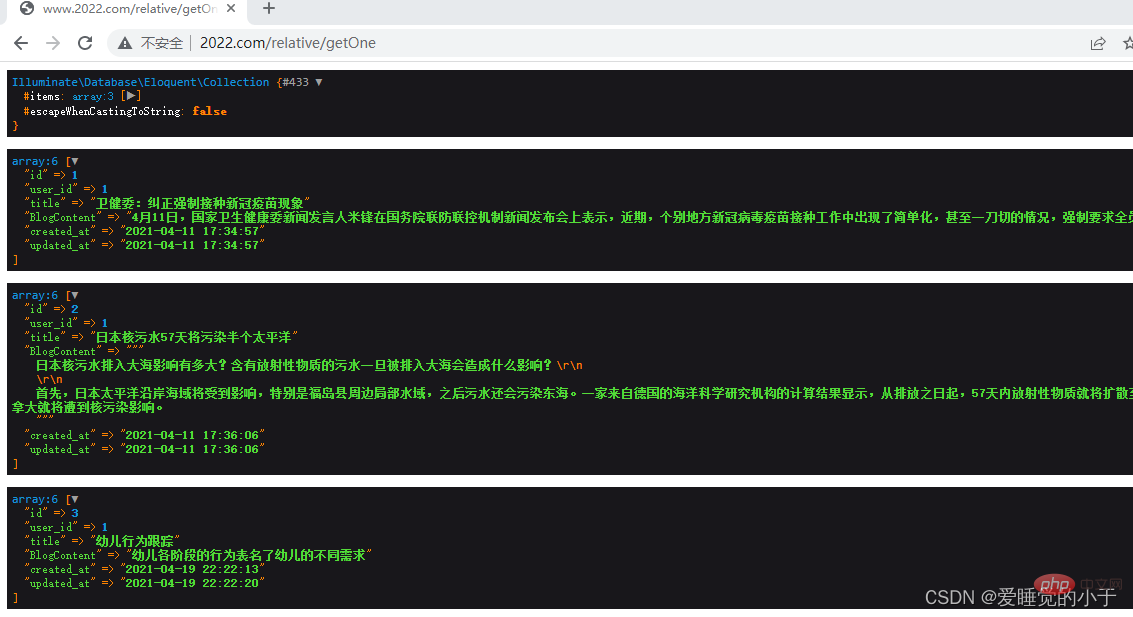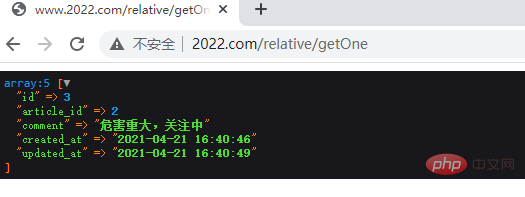Detailed analysis of Laravel Model model association
This article brings you relevant knowledge about laravel, which mainly introduces related issues about Model model association, including one-to-one, one-to-many, many-to-many, etc. , let’s take a look at it, I hope it will be helpful to everyone.

[Related recommendations: laravel video tutorial]
Define association relationships
Database tables are usually related to each other.
For example, a blog post may have many comments, or an order may correspond to one ordering user. Eloquent makes the management and use of these associations simple, and supports multiple types of associations: the first three are the most common, and here we only explain the first three associations
- One-to-one
- One-to-many
- Many-to-many
- Remote one-to-many
- Remote one-to-one
- One-to-one (polymorphic association )
- One-to-many (polymorphic association)
- Many-to-many
Establish model association
One-to-one
Example:
Two data tables: guest User table and guestinfoUser information
where guest The primary key id field in the table corresponds to the foreign key user_id field First create two model files:
php artisan make:model Guestphp artisan make:model Guestinfo Guest model file:
class Guest extends Model{
use HasFactory;
// 设置Guest模型对应的数据表
protected $table = 'guest';
// 关闭create_time和update_time字段自动管理
public $timestamps = false;
// 设置与guestinfo的关联方法,方法名建议使用被关联表的名字
public function guestinfo(){
// hasOne(被关联的名命空间,关联外键,关联的主键)
return $this->hasOne('App\Models\Guestinfo','user_id','id');
}}Guestinfo model file:
class Guestinfo extends Model{
use HasFactory;
// 设置Guest模型对应的数据表
protected $table = 'guestinfo';
// 关闭create_time和update_time字段自动管理
public $timestamps = false;
// 设置与guestinfo的关联方法,方法名建议使用被关联表的名字
public function guest(){
// hasOne(被关联的名命空间,关联外键,关联的主键)
return $this->belongsTo('App\Models\Guest','user_id','id');
}}Create a controller to connect the two model files:
php artisan make:controller Controllers Content:
class Controllers extends Controller{
//
public function getOne(){
// 通过关联方法获取guest表中username = admin记录在guestinfo对应的记录
// ->guestinfo 是Guest模型文件里面定义的guestinfo方法
$guestInfo = Guest::firstWhere('username','admin')->guestinfo;
// 通过关联方法获取guestinfo中id=3 记录在guest表中的对应记录
$data = Guestinfo::find(3)->guest;
dump($guestInfo);
// 将模型转换成数组
dump($data->toArray());
}}Create the route of the controller:
Route::get('relative/getOne',[Controllers::class,'getOne']); Access route: The result is: 
Example:
Two data tables: guest
User table and article Article table where the primary key id
field in the guest table corresponds to the foreign key user_id field created in guestinfo article
model file: php artisan make:model Article<div class="code" style="position:relative; padding:0px; margin:0px;"><pre class="brush:php;toolbar:false">class Article extends Model{
use HasFactory;
// 设置Guest模型对应的数据表
protected $table = 'article';
// 关闭create_time和update_time字段自动管理
public $timestamps = false;
public function guest(){
// 设置与guest的关联方法,与一对一的从表设置一样
return $this->belongsTo('App\Models\April\Guest','user_id','id');
}}</pre><div class="contentsignin">Copy after login</div></div>Add an
Guest model file ## Method
class Guest extends Model{
use HasFactory;
// 设置Guest模型对应的数据表
protected $table = 'guest';
// 关闭create_time和update_time字段自动管理
public $timestamps = false;
// 设置与guestinfo的关联方法,方法名建议使用被关联表的名字
public function guestinfo(){
// hasOne(被关联的名命空间,关联外键,关联的主键)
return $this->hasOne('App\Models\Guestinfo','user_id','id');
}
// 设置与article的关联:hasmany 有很多
public function article(){
return $this->hasMany('App\Models\April\Article','user_id','id');
}} Test it in the Controllers controller file: Example 1: Query all articles published by a user: <div class="code" style="position:relative; padding:0px; margin:0px;"><pre class="brush:php;toolbar:false"> // 查询某个用户发表的所有文章
$article = Guest::find(1)->article;
// 返回为数据集,需要遍历
foreach ($article as $v){
dump($v->toArray());
}</pre><div class="contentsignin">Copy after login</div></div>
Example 2: Query the latest article published by a user
// 查询某个用户最新发表的一篇文章
// article()生成一个构造器,可以进行筛选
$article = Guest::find(1)->article()->orderby('created_at','desc')->first();
dump($article->toArray());// 通过article和guest关联,再通过guest关联的guestinfo获取姓名 $name = Article::find(2)->guest->guestinfo; dump($name->name);
 Example 4: Query the comment information of an article through association
Example 4: Query the comment information of an article through associationCreate Comment model:
php artisan make:model Comment
Comment model code: <div class="code" style="position:relative; padding:0px; margin:0px;"><pre class="brush:php;toolbar:false">class Comment extends Model{
use HasFactory;
// 设置Comment模型对应的数据表
protected $table = 'comment';
// 关闭create_time和update_time字段自动管理
public $timestamps = false;
// 设置与article的关联方法,方法名建议使用被关联表的名字
public function article(){
return $this->belongsTo('App\Models\April\Article','article_id','id');
}}</pre><div class="contentsignin">Copy after login</div></div>Add method comment in the Article model:
public function comment(){
return $this->hasMany('App\Models\April\Comment','article_id','id');
}$info = Article::find(2)->comment;
foreach ($info as $v){
dump($v->toArray());
}laravel video tutorial 】
】
The above is the detailed content of Detailed analysis of Laravel Model model association. For more information, please follow other related articles on the PHP Chinese website!

Hot AI Tools

Undresser.AI Undress
AI-powered app for creating realistic nude photos

AI Clothes Remover
Online AI tool for removing clothes from photos.

Undress AI Tool
Undress images for free

Clothoff.io
AI clothes remover

AI Hentai Generator
Generate AI Hentai for free.

Hot Article

Hot Tools

Notepad++7.3.1
Easy-to-use and free code editor

SublimeText3 Chinese version
Chinese version, very easy to use

Zend Studio 13.0.1
Powerful PHP integrated development environment

Dreamweaver CS6
Visual web development tools

SublimeText3 Mac version
God-level code editing software (SublimeText3)

Hot Topics
 1386
1386
 52
52
 Laravel - Artisan Commands
Aug 27, 2024 am 10:51 AM
Laravel - Artisan Commands
Aug 27, 2024 am 10:51 AM
Laravel - Artisan Commands - Laravel 5.7 comes with new way of treating and testing new commands. It includes a new feature of testing artisan commands and the demonstration is mentioned below ?
 Laravel - Pagination Customizations
Aug 27, 2024 am 10:51 AM
Laravel - Pagination Customizations
Aug 27, 2024 am 10:51 AM
Laravel - Pagination Customizations - Laravel includes a feature of pagination which helps a user or a developer to include a pagination feature. Laravel paginator is integrated with the query builder and Eloquent ORM. The paginate method automatical
 How to get the return code when email sending fails in Laravel?
Apr 01, 2025 pm 02:45 PM
How to get the return code when email sending fails in Laravel?
Apr 01, 2025 pm 02:45 PM
Method for obtaining the return code when Laravel email sending fails. When using Laravel to develop applications, you often encounter situations where you need to send verification codes. And in reality...
 Laravel schedule task is not executed: What should I do if the task is not running after schedule: run command?
Mar 31, 2025 pm 11:24 PM
Laravel schedule task is not executed: What should I do if the task is not running after schedule: run command?
Mar 31, 2025 pm 11:24 PM
Laravel schedule task run unresponsive troubleshooting When using Laravel's schedule task scheduling, many developers will encounter this problem: schedule:run...
 In Laravel, how to deal with the situation where verification codes are failed to be sent by email?
Mar 31, 2025 pm 11:48 PM
In Laravel, how to deal with the situation where verification codes are failed to be sent by email?
Mar 31, 2025 pm 11:48 PM
The method of handling Laravel's email failure to send verification code is to use Laravel...
 How to implement the custom table function of clicking to add data in dcat admin?
Apr 01, 2025 am 07:09 AM
How to implement the custom table function of clicking to add data in dcat admin?
Apr 01, 2025 am 07:09 AM
How to implement the table function of custom click to add data in dcatadmin (laravel-admin) When using dcat...
 Laravel - Dump Server
Aug 27, 2024 am 10:51 AM
Laravel - Dump Server
Aug 27, 2024 am 10:51 AM
Laravel - Dump Server - Laravel dump server comes with the version of Laravel 5.7. The previous versions do not include any dump server. Dump server will be a development dependency in laravel/laravel composer file.
 Laravel Redis connection sharing: Why does the select method affect other connections?
Apr 01, 2025 am 07:45 AM
Laravel Redis connection sharing: Why does the select method affect other connections?
Apr 01, 2025 am 07:45 AM
The impact of sharing of Redis connections in Laravel framework and select methods When using Laravel framework and Redis, developers may encounter a problem: through configuration...




